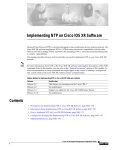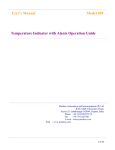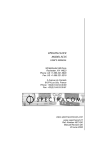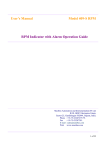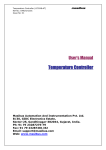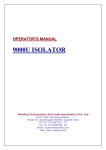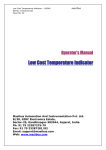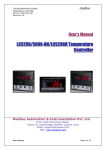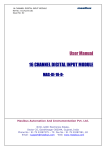Download GPS masTER CLOCK - Instrumentation and Automation Solutions
Transcript
GPS masTER CLOCK masibus Model: MC-I Doc Ref No: m05/om/101 Issue No:07 Jan 25, 2011 OPERATOR’S MANUAL GPS masTER CLOCK MASIBUS AUTOMATION & INSTRUMENTATION (P) LTD B-30 GIDC, Electronics Estate, Gandhinagar – 382044, Gujarat, India Ph No: 91-79-23287275/23287279 Fax No: 91-79-23287281/23287282 Email: [email protected], [email protected] Operator’s Manual Page 1 of 36 GPS masTER CLOCK masibus Model: MC-I Doc Ref No: m05/om/101 Jan 25, 2011 Issue No:07 Website: www.masibus.com CONTENTS 1. Introduction 2. Specifications 3. Time Signal Outputs 3.1 The 1 PPS Signal 3.2 The Event Signal 3.3 The IRIG-B Signal (Optional) 3.4 NTP / SNTP Time Protocol (Optional) 3.5 Event Outputs 3.6 RS232 Outputs 3.6.1 NMEA ($GPRMC) Format 3.6.2 NGTS Format 3.6.3 T-Format Format 4. Installation 4.1 Packing List 4.2 Mounting the Unit 4.3 Mounting the Antenna 4.4 Antenna Cable 4.5 Suggested Assembly Order 4.6 Self Monitoring 4.7 Available Alarms 4.8 Time Output Ports 5. Connection Diagram 6. User Configuration 6.1 Initializing the Configuration 6.2 Precautions 6.3 Configuration Command & Password 6.4 Communication Commands 6.5 Time Zone Offset Command 6.6 LCD Display Commands 6.7 Command For Selection of Format on COM2 6.8 Event Command 6.9 Additional Event Outputs. 6.10 COMMAND to set default IP address,Subnet mask & Gateway 6.11 Password Command 6.12 Miscellaneous Commands 6.13 Example Appendices A. The Global Positioning System (GPS) B. Applicability of GPS masTER CLOCK C. Health & Safety Statement Operator’s Manual Page 2 of 36 GPS masTER CLOCK masibus Model: MC-I Doc Ref No: m05/om/101 Jan 25, 2011 Issue No:07 1. INTRODUCTION Masibus’ GPS masTER CLOCK has been developed to address key power and process industry timing requirements. Whether it’s the monitor, control or analysis of the power system, the GPS masTER CLOCK is the cost-effective GPS time synchronization solution. To begin with, the GPS masTER CLOCK offers superb timing accuracy (±1µs to UTC). Using GPS satellites, it generates extremely accurate output pulses and time codes in multiple formats. The GPS masTER CLOCK synchronizes a wide variety of microprocessor-based power system equipment including: SCADA systems, remote terminal units (RTUs), protection relays, sequence of event recorders, digital fault recorders, tariff meters, Slave Display Units, Data Loggers and other Intelligent Electronic Devices (IEDs). Being a Field programmable device using HyperTerminal, a very common application in Windows, the GPS masTER CLOCK allows the user to alter the settings or choose from Time codes. The serial port COM2 (RS232) is provided for that purpose. Each output can feed directly to different areas through electrically isolated ports which ensure reliable operation in a harsh substation environment. The GPS masTER CLOCK generates a wide range of timing signals via six output ports. The GPS masTER CLOCK is defaulted with two serial ports, a 1 PPS Port, 1 RJ-45 NTP port and four relay outputs. A fixed serial port provides NMEA 0183 $GPRMC format data. Second serial port is configurable for either NGTS or T-format. Another fixed output provides a very accurate pulse per second with accuracy of ±1µs to UTC. Optional outputs include an IRIG-B DC Level Shift, an IRIG-B Amplitude Modulated (AM) time code signals and 4 additional event outputs. Time synchronization protocol (NTP) standard as Server/Broadcast mode implemented in GPS to provide time synchronization to different slaves supporting NTP protocols. All GPS masTER CLOCK units feature a front panel display, giving both installation teams and users visual feedback about the time data being generated on the outputs. LED indicators provide “at a glance” status information. The optimized Receiver/Antenna system employed in the GPS masTER CLOCK provides time information from the GPS satellite constellation. Dynamic T-RAIM processing is used to eliminate any aberrant satellite signals from the timing solution. The result is timing precision on all outputs with accuracy similar to that normally seen only in laboratory instruments. The GPS masTER CLOCK unit occupies the size of 19” x 12” x 3.5”. It is supplied complete with all hardware and software required for the installation, including the Antenna, Antenna mounting kit, 10 meters Antenna cable, 3 meters RS-232 cable and 10 meters RG58 Co-axial cable. Operator’s Manual Page 3 of 36 GPS masTER CLOCK masibus Model: MC-I Doc Ref No: m05/om/101 Jan 25, 2011 Issue No:07 2. SPECIFICATIONS RECEIVER CHARACTERISTICS 1 PPS ±1 µs Accuracy with GPS locked TTL into 50 Ω Rising Edge on time Rise Time: < 15 ns 200 ms Pulse Width Rear Panel BNC Female Maximum Distance: 10 meters Isolation of 2000 MΩ at 500 VDC from all other ports. Timing Accuracy <2 ns in the presence of Selective Availability (SA) and tracking of 12 satellites Positioning Accuracy <25m SEP without SA Receiver Input 1575.42 MHz L1 C/A Code Serial NMEA-0183-$GPRMC on COM 1 NGTS/ T-Format on COM 2 9600-8-N-1 on parameters COM1 4800/9600-7/8-N/E/O-1/2 on COM2 Isolation of 2000 MΩ at 500 VDC from all other ports. DB9 Female Connectors Maximum Distance of 50 mts. Tracking 12 parallel channels Acquisition Time Hot Start: <25 s Warm Start: <50 s Cold Start: < 200 s Memory Backup Internal 5 mAh cell Sufficient for 2 weeks of backup time Needs 24-36 hours run for full charging Antenna L1 GPS, 25 dB Gain, RG8/58/9913 Cable Maximum length: 100m (In noise free environment with LMR400) OPTIONAL OUTPUTS Event One Event per minute or per hour 350 DC, 120mA maximum 8-Way Terminal Strip Suitable Electric Wire: 22~14 AWG Isolation of 2000 MΩ at 500 VDC from all other ports FIXED OUTPUTS Alarms Pulse Operator’s Manual Page 4 of 36 GPS masTER CLOCK masibus Model: MC-I Doc Ref No: m05/om/101 Jan 25, 2011 Issue No:07 Three Isolated Dry Contacts to 230 V AC, 10 A: 1. GPS Lost 2. Watchdog 3. Power Fail 8-Way Terminal Strip Suitable Electric Wire: 22~14 AWG IRIGB-TTL Serial Code with DC Level Shift TTL into 50 Ω Rise Time: < 15ns Rear Panel BNC Female Maximum Distance: 10 meters Isolation of 2000 MΩ at 500 VDC from all other ports. IRIGB-Modulated 1 KHz AM Signal 3:1 Modulation Ratio 0-10Vpp (Unloaded) 0-3 Vpp (50 Ω load) Rear Panel BNC Female 150 Ω Output Impedance Isolation of 2000 MΩ at 500 VDC from all other ports. Ethernet Output: Time Synchronization protocols: NTP/SNTP Server [Factory settable] NTP: Network Time Protocol (All versions compatible) TP: RFC- 1059, RFC- 1119, RFC1305 SNTP: RFC- 1361 Network Protocol OSI Layer4 Transport layer: UDP Internet protocol: IPv4 Modes: Server / Broadcast Protocol Time format: UTC Protocol standard: Universal Time Output port: Rear Panel RJ-45 Network Interface: 1 x 10Mbps Isolation of 2000 MΩ at 500 VDC from all other ports. ON Time: min. 200 milliseconds and max 50% of period time set for particular event Event contact capacity: 350 DC, 120mA maximum Isolation: 2000 MΩ at 500 VDC from all other ports. INTERFACE Display 99x24 mm, 2x16 LCD with Backlit Displayed data Time of Day (HH:MM:SS) Day of week Date (DD/MM/YY) Latitude, Longitude, Height Number of satellites available Data Format on COM2 Parameters of both serial ports GPS status information Status LED Power PPS Event Watchdog GPS Locked : : : : : Red Red Red Red Green Programming Using HyperTerminal in a local PC via COM2 Programmable parameters: • Global Time zone correction • 12/24 Hrs Format of Time • COM2 serial port setting • COM2 data format selection (NGTS or T-FORMAT) • Duration of Programmable repetitive event generation output via dry contact (Per Minute or Hour). • Password Protection Network Settings Additional Event Outputs Four independent configurable Event outputs Individual configurable time period and pulse ON time through COM2 Time Period: 1 to 86400 seconds (24 Hr.) max Operator’s Manual • • IP address, Subnet mask, Gateway configurable through Telnet remote login. All network configurations are password protected. Page 5 of 36 GPS masTER CLOCK masibus Model: MC-I Doc Ref No: m05/om/101 Jan 25, 2011 Issue No:07 POWER SUPPLY AC : 90 to 260 V, 47-440 Hz, 1φ DC : 110-340 V Power Consumption: 15W Compliance: FCC-B, CISPR22-B, EN55022-B, VCCI-B Humidity 90% at +40° C (Non-condensing) Conducted & Radiated Noise Tested immunity to 10 KV Ignition Transformer Noise PHYSICAL DIMENSIONS EXTRA MODULE (OPTIONAL) 19” Rack Mountable: Width : 426 mm (18.35”) Depth : 300 mm (11.84”) Height : 2 U – 88 mm (3.46”) Weight: 4 Kg RS232-to-RS485 Converter Maximum Distance: 1.2 km Power Requirement: 24 V DC ENVIRONMENT Temperature Operating: 0° C to +45° C Storage: -40° C to +85° C 3. TIME SIGNAL OUTPUTS 3.1 The 1pps Signal This is a very important timing signal. It is the TTL level pulse with a width of 200ms isolated output coming from the GPS receiver. This 1pps is connected to the BNC connector on the rear panel. 3.2 The Event Signal The signal is an isolated event output through a static relay contact. This signal is connected to two of the terminal of the 8 way barrier strip on the rear panel of the device the event is assigned as isolated event; the frequency for this event can be configured as 1 minute or 1 hour. The pulse width of the event is 1 second. 3.3 The IRIG-B Signal The IRIG-B format is a serial format based on a message frame per second which is Coordinated with the synchronized 1pps time output pulse. There are two alternative forms of output, a dc level shift output, and a modulated output. The modulation frequency is 1 KHz. For each form of output there are three output codes:a. A Reference Mark b. A logical 1 Operator’s Manual Page 6 of 36 GPS masTER CLOCK masibus Model: MC-I Doc Ref No: m05/om/101 Jan 25, 2011 Issue No:07 c. A logical 0 For IRIG-B, each one of these codes is 10 ms long, which is 10 cycles for the modulated format. There are 100 possible codes per time frame, although not all of them are used. The code sequence is shown in Table 1, and the waveforms shown in Figure 2. The day number starts at 1 on the first of January. The output voltage of the modulated waveform is 3 V peak to peak into a 50 ohms load. The dc level output is TTL standard and the rising edge of the pulse is "On Time". 1 kHz modulated IRIG-B signal is connected to BNC on the rear panel of the device. IRIG-B TTL level signal is connected to a BNC connector on the rear panel of the device. Position Type 0 1 2 3 4 5 6 7 8 9 10 11 12 13 14 15 16 17 18 19 20 21 22 23 24 25 26 Reference Mark Signal Signal Signal Signal Logical 0 Signal Signal Signal Reference Mark Signal Signal Signal Signal Logical 0 Signal Signal Signal Logical 0 Reference Mark Signal Signal Signal Signal Logical 0 Signal Signal Item Digit Seconds Seconds Seconds Seconds 1 2 4 8 Seconds Seconds Seconds 10 20 40 Minutes Minutes Minutes Minutes 1 2 4 8 Minutes Minutes Minutes 10 20 40 Hours Hours Hours Hours 1 2 4 8 Hours Hours 10 20 Position Type 27 to 28 29 30 31 32 33 34 35 36 37 38 39 40 41 42 to 48 49 50 to 58 59 60 to 68 69 70 to 78 79 80 to 88 89 90 to 98 99 Logical 0 Reference Mark Signal Signal Signal Signal Logical 0 Signal Signal Signal Signal Reference Mark Signal Signal Logical 0 Reference Mark Logical 0 Reference Mark Logical 0 Reference Mark Logical 0 Reference Mark Logical 0 Reference Mark Logical 0 Reference Mark Item Digit Day Day Day Day 1 2 4 8 Day Day Day Day 10 20 40 80 Day Day 100 200 Table 1 – IRIG B Code Sequence Operator’s Manual Page 7 of 36 GPS masTER CLOCK masibus Model: MC-I Doc Ref No: m05/om/101 Jan 25, 2011 Issue No:07 3.4 NTP / SNTP Time Protocol (Optional): 3.4.1. Introduction: NTP(Network time protocol) is a common method for synchronization of hardware clocks in local and global networks. The software package NTP is an implementation of the actual version 3 [Mills90], based on the specification RFC-1305 from1990 (directory doc/NOTES). Other NTP compatible Versions are NTPv1 (RFC-1059), NTPv2(RFC-1119), RFC-958. GPS is being provided with Internal protocol based Universal time synchronization protocol i.e. SNTP (Simple Network Time Protocol) / NTP (Network Time Protocol) used to synchronize the various clocks of NTP clients to adjust with universal time. SNTP uses the standard NTP timestamp format described in RFC-1305. Network Time Protocol is widely used to synchronize the time for Internet hosts, routers and ancillary devices to Coordinated Universal Time (UTC) as disseminated by national standards laboratories. Operator’s Manual Page 8 of 36 GPS masTER CLOCK masibus Model: MC-I Doc Ref No: m05/om/101 Jan 25, 2011 Issue No:07 3.4.2. NTP: GPS time protocol is transmitted via RJ-45 connector on UDP layer (RFC-768) at 10 Mbps provided on rear panel of GPS. GPS transmits NTP packets in various optional modes i.e. Server / Server Broadcast depending on the applications of client module. NTP packets involve the timestamp value according to UTC (Universal Time) time. Server mode: GPS responses with current timestamp when the query is received from client. Broadcast mode: GPS broadcasts the NTP packet at fixed intervals to clients. Note: a) NTP Version, Mode value in NTP packet is factory set. b) Network IP, Subnet Mask and Gateway of GPS can be changed through Telnet. Refer document m05/om/101-3 Appendix E for configuring GPS master clock as Telnet Server. c) Refer document m05/om/101-1 Appendix C for configuring Windows XP PC as NTP Client. d) Refer document m05/om/101-1 Appendix D for configuring Unix PC as NTP Client. Above figure shows the example of NTP packet transmitted containing different parameters. Operator’s Manual Page 9 of 36 GPS masTER CLOCK masibus Model: MC-I Doc Ref No: m05/om/101 Jan 25, 2011 Issue No:07 3.4.3. NTP Packet format: Above figure shows the NTP packet header format. Following is the description of each parameter in NTP Packet: leap 2-bit integer warning of an impending leap second to be inserted or deleted in the last minute of the current month, coded as follows: 0 no warning 1 last minute of the day has 61 seconds 2 last minute of the day has 59 seconds 3 alarm condition (the clock has never been synchronized) version. 3-bit integer representing the NTP version number. mode 3-bit integer representing the mode, with values defined as follows: 4 server Peer clock stratum 8-bit integer representing the stratum, with values defined as follows: 0 unspecified or invalid 1 primary server (e.g., equipped with a GPS receiver) 2-255 secondary server (via NTP) Polling interval 8-bit signed integer representing the maximum interval between successive messages. Clock precision 8-bit signed integer representing the precision of the system clock. GPS is having clock precision of 1 us (I microseconds = 0.000001s) Operator’s Manual Page 10 of 36 GPS masTER CLOCK masibus Model: MC-I Doc Ref No: m05/om/101 Jan 25, 2011 Issue No:07 Root Delay Total roundtrip delay to the reference clock, in NTP short format. Root Dispersion Total dispersion to the reference clock, in NTP short format. Reference clock id. 32-bit code identifying the particular server or reference clock. GPS Global Positioning System Reference clock update time Time when the system clock was last set or corrected, in NTP timestamp format. Originate timestamp Time at the client when the request departed for the server, in NTP timestamp format. Receive timestamp Time at the server when the request arrived from the client, in NTP timestamp format. Transmit timestamp Time at the server when the response left for the client, in NTP timestamp format. To configure PC as a NTP client, please refer document m05/om/101-1 Appendix C document. OR You can Access Procedure for configuring Windows XP using NTP server on the link http://support.microsoft.com/. Operator’s Manual Page 11 of 36 GPS masTER CLOCK masibus Model: MC-I Doc Ref No: m05/om/101 Jan 25, 2011 Issue No:07 3.5 Event Outputs / BCD Time Format Output (Optional) Event Outputs The additional four event signals are available at the terminal strip on the rear panel of the GPS masTER CLOCK. User can configure these relays through COM2 for time ranging from 1 to 86400 seconds individually for separate event outputs. User can configure their Time period as well as their ON time through COM2 port. Time Period limit: 1 to 86400 seconds (0 values are to inhibit/stop particular event output). ON time limit: 200 milliseconds (min.) to 50% (max.) of particular event time period. Ensure that ON time value of all additional events are to be entered in milliseconds. (If time period is 0, the ON time will be also 0 by default). Whenever the new time period is set, the new event timing counter will start from the very next minute and the contact will be energized after the settable time for that particular event. Please ensure to switch power of the instrument OFF and ON once if the event time period settings are changed. 3.6 RS232 Outputs There are two RS232 serial ports equipped within the device. These two serial ports use two separate high performance chips to get electrical isolation. Each serial port has its own format of the timing strings. On serial port one, 9 ways D-type socket, the message is NMEA ($GPRMC) format. The serial port two, 9 way D-type plug, the message is NGTS or T-FORMAT. 3.6.1 NMEA Format RMC RECORD FORMAT The $GPRMC sentence contains time and date of position fix, speed and course information.The following examples show the contents of a typical RMC sentence: The settings for this serial format is 4800, 8, N, 1. The full data message of this format shall consist of data fields as follows: Field Sentence ID UTC Time Status Latitude N/S Indicator Longitude E/W Indicator Speed over ground Operator’s Manual Example $GPRMC, 130525.00, A, 4250.5589, S, 14518.5084, E, 000.1, Comments hhmmss.ss, A = Valid/V = Invalid, ddmm.mmmm, N = North/S = South, dddmm.mmmm, E = East/W = West, Knots, Page 12 of 36 GPS masTER CLOCK masibus Model: MC-I Doc Ref No: m05/om/101 Jan 25, 2011 Issue No:07 Course over ground UTC Date Magnetic variation Magnetic variation Checksum Terminator 245.0, 291206, , , *25 <CR><LF> Degrees, DDMMYY, Degrees, E = East/W = West, *CC Non-printing characters Table 3: RMC Record Selection 3.6.2 NGTS Format The settings for this format are programmable. The full data message of NGTS format shall consist of 14 printable characters and a concluding CRLF as follows: Description Code Identification Year in Century Month Day of Month Day of Week Hours Minutes GMT Marker Validity Marker CRLF Number of Characters 1 2 2 2 1 2 2 1 1 2 Character Position 1 2,3 4,5 6,7 8 9,10 11,12 13 14 15,16 Range of Value/Information Capital T 0 to 99 1 to 12 1 to 31 1 to 7 0 to 23 0 to 59 0 or 1 0 or 1 Non-printing character Table 4: NGTS Format The transmission sequence shall be from the Code Identification character through to the CRLF with the most significant digits being transmitted first. The message shall become automatically available at one second prior to the clock minute epoch. 3.6.3 T-Format The settings for this format are programmable. The full data message of T-format shall consist of 21 printable characters with a concluding CRLF as follows: Description Code Identification Divider Year in Century Divider Month Divider Day of Month Divider Day of Week Divider Hours Operator’s Manual Number of Characters 1 1 2 1 2 1 2 1 1 1 2 Character Position 1 2 3,4 5 6,7 8 9,10 11 12 13 14,15 Range of Value/Information Capital T : 0 to 99 : 1 to 12 : 1 to 31 : 1 to 7 : 0 to 23 Page 13 of 36 GPS masTER CLOCK masibus Model: MC-I Doc Ref No: m05/om/101 Jan 25, 2011 Issue No:07 Divider Minutes Divider GMT Marker Validity Marker CRLF 1 2 1 1 1 2 16 17,18 19 20 21 22,23 : 0 to 59 : 0 or 1 0 or 1 Non printing character Table 5: T- Format 4. INSTALLATION 4.1 Packing List Each GPS masTER CLOCK is shipped with the following: • GPS masTER CLOCK, Model MC-I time source with Regular outputs • User Manual (This Document) • Timing 3000 GPS antenna • Antenna Mounting Kit • 10 meters LMR- 195 Antenna Cable with N-to-BNC connectors • 19” Rack mounting plate and fasteners • 3 meters RS-232 Interface cable (Male to Female) • 10 meters RG-58 Co-axial cable with BNC Male Connectors • masTER SYNC Software for PC Synchronization 4.2 Mounting the Unit The GPS masTER CLOCK is designed to be mounted in a 19 inch rack, but may be used on a bench. The unit is attached with to the rack mount via four screws in the four corners of the front panel. The device should be installed inside a control room or suitable place without directly effected by the changing of the condition of the weather. The environment temperature should meet the requirement of the device. 4.3 Mounting the Antenna The Antenna should be located in a position with as clear a view of the sky as possible, over as wide an angle as possible. An absolute minimum is for it to have a view of 90% of the sky. It should be mounted at least 0.5m clear of near by walls or other objects. The antenna should also be mounted in a “Lightning-protected zone”, as far as is possible. In practice, this means ensuring that there is at least one other ground-bonded structure located in the same rooftop area (e.g. lightning rod) that reaches significantly higher than the top of the GPS antenna. The GPS antenna should be mounted so that it lies within a 45-degree angle “skirt” from the top of the other ground-bonded structure. The GPS antenna mount itself should also be securely bonded directly to the building protection ground – and not connected via any other grounded structures. The mounting kit can be fastened to wall or fitted to the pipe using the screws supplied. The antenna should be first placed through the hole of the mounting kit and then the antenna cable should be fitted. The antenna erection at right angle wrt the ground is a must. Operator’s Manual Page 14 of 36 GPS masTER CLOCK masibus Model: MC-I Doc Ref No: m05/om/101 Jan 25, 2011 Issue No:07 4.4 Antenna Cable The cable used must be with sufficient shielding. If the shielding is not sufficient, the cable should not be in close proximity to power or other RF cables carrying transmitter signals- in particular, parallel runs are to be avoided if possible. If such runs are absolutely unavoidable, a minimum separation of 30 cm may be used as a guideline. The GPS receiver embedded in the GPS masTER CLOCK has excellent OOB rejection characteristics, as does the antenna itself. However, sound engineering practice should not rely on these factors alone to guarantee performance. Careful installation will enhance the long-term reliability and on-going stability of the GPS masTER CLOCK. The maximum length of the cable is 100 meters when the LMR400 or Belden 9913 cable is used. If the distance to be carried. 4.5 Suggested Assembly Order The installation of GPS masTER CLOCK is very simple. Follow these steps: • • • • • Connect GPS receiver antenna. The antenna should be at sufficient height and in open surrounding, with no obstacles nearby. Please follow the above stated guidelines. Make sure your power supply is in compliance with the specification and then connect power supply. Make the connections between time signal outputs and corresponding devices. Connect the alarm signals to respective devices. Figure 4 show the views of front panel and rear panel of the GPS masTER CLOCK device respectively. o o On the front panel of the device, there is a 2*16 characters LCD display. There are five LEDs. These LEDs indicate the status of the device. LED ‘POWER’ is the indicator for power supply. Operator’s Manual Page 15 of 36 GPS masTER CLOCK masibus Model: MC-I Doc Ref No: m05/om/101 Jan 25, 2011 Issue No:07 LED ‘GPS LOCKED’ is the indicator for GPS locked. LED ‘EVENT’ is the indicator for event output. LED ‘1 pps’ is the indicator for one pulse per second output. LED ‘WATCHDOG’ will be lit only when the application program has been stopped for some reason. All wiring connections are located on the rear panel of the device. Power supply connector and one power supply fuse is also present at the rear panel. o ANTENNA is used for connection of the GPS receiver antenna. o COM1 is a 9 way D-type socket and the time message is NMEA ($GPRMC) format on this serial communication port. o COM2 is a 9 way D-type plug and the time message is standard NGTS or T-FORMAT on this serial port. o There are also three BNC connectors on the rear panel. One with label ‘1PPS’ is the TTL level output of one pulse per second signal. One with label ‘IRIG-B TTL’ is the dc level shift IRIG-B signal output. One with label ‘IRIG-B MOD’ is the modulated 1 KHz IRIG-B signal output. o NTP is RJ-45 female Ethernet connector provides NTP (Ethernet) output for synchronization of NTP clients with GPS. o Three pairs of alarm contacts are located between terminals 1 and 2, terminals 3 and 4, terminals 5 and 6 respectively. They are assigned as ‘WATCHDOG’, ‘POWER FAIL’ and ‘GPS LOST’ accordingly. o Optional output- There are 4 additional event outputs/contacts EVENT1, EVENT2, EVENT3, EVENT4 provided on GPS rear terminal each with 350 VAC @ 120mA (max) capacity. • • On first installation after about 15 days of off-state, the instrument may initially show incorrect time because the battery of the receiver could be discharged. It is required to run the system for 24 hours continuously to completely recharge the battery and with antenna, so that it can get the correct time. 4.6 SELF MONITORING After the connections of power supply and GPS antenna, the device is ready to be switched on. • As soon as power is switched on, the green LED ‘POWER’ will be lit. • The LCD display will also be lit and display some message as shown in figure 5(a) to 5(d). • The first screen of the LCD display is the name of manufacturer (Figure 5(a)). The second screen is the message for settings of two serial communication ports. The third screen is name of the device and the message ‘Connecting….’ will be displayed until the device locks with the GPS receiver signal. This may be as long as a few minutes. • For the first time when the device is switched on, the exact location will not be available for 2-15 minutes after the GPS has locked. This will depend on the duration the device has been switched off and the distance the device has been moved. • After the device is locked with satellite signals, the green LED ‘GPS LOCKED’ will be lit. The LCD display will restore to normal display situation. The normal display screen shown as in Figure 5(d). Operator’s Manual Page 16 of 36 GPS masTER CLOCK masibus Model: MC-I Doc Ref No: m05/om/101 Jan 25, 2011 Issue No:07 4.7 AVAILABLE ALARMS Three alarm contacts are available on the connector block. They can be used to indicate operation of the instrument to any remote device. The alarm contacts are all dry contacts with ratings as detailed in the specification. They are all in open positions when the system is working correctly, and closed in the event of a failure. The events covered are: (a) No power to the instrument (b) Watchdog failure (i.e. firmware problem) (c) GPS not locked. Alarm (a) can be checked by switching the instrument off and checking that the contact closes. Alarm (b) cannot be checked on site, and alarm (c) should give an alarm when the instrument is first switched on before the clock synchronizes. Operator’s Manual Page 17 of 36 GPS masTER CLOCK masibus Model: MC-I Doc Ref No: m05/om/101 Jan 25, 2011 Issue No:07 MASIBUS AUTO. & INSTR. PVT. LTD. Figure 5.a COM 1: 9600 - N - 8 - 1 COM 2: 9600 - N - 8 - 1 Figure 5.b GPS masTER CLOCK CONNECTING……... Figure 5.c TIME: 12 : 00 : 00 DATE: 01 / 01 / 07 Figure 5.d Figure – 5 4.8 TIME OUTPUT PORTS A wide range of time related output signals are available from this instrument to suit a wide range of possible applications. To complete installation of the instrument all that remains is to couple the required outputs to the associated equipment, taking due account of permitted signal output levels as detailed in the specification section. Operator’s Manual Page 18 of 36 GPS masTER CLOCK masibus Model: MC-I Doc Ref No: m05/om/101 Jan 25, 2011 Issue No:07 The following is a summary of the signals available from the various terminals, and sockets. Connector 9 pin D type COM1 Signal RS-232 9 pin D type COM2 RS-232 Description NMEA format message Pin 2: Serial Receive Pin 3: Serial Transmit (NMEA Output) Pin 4: 1 PPS Pin 5: Ground Standard NGTS or T-FORMAT message Input – Local PC configuration COM2 can be programmed to give different output formats if required. Pin 2: Serial Receive Pin 3: Serial Transmit (NGTS/T-Format Output) Pin 4: 1 PPS (for T-Format)/ 1 PPM (for NGTS) Pin 5: Ground Programmable output (Assigned as isolated event), it is an isolated event through a static relay, this event is indicated by the ‘EVENT’ LED. Event Terminal strip WATCHDOG Terminal Strip-2 BNC BNC BNC RJ-45 POWER GPS LOCK Event - 1 Event - 2 Event - 3 Event – 4 TTL Pulse AM Signal TTL String Ethernet Alarm output when firmware is not working properly. Alarm output when there is a power failure. Alarm output when there is a GPS sync loss. Additional Programmable output Additional Programmable output Additional Programmable output Additional Programmable output 1pps signal 1 kHz IRIG B Modulated Signal IRIG B DC Shift Signal SNTP Output/NTP Output Table 6: Available Time Outputs Operator’s Manual Page 19 of 36 GPS masTER CLOCK masibus Model: MC-I Doc Ref No: m05/om/101 Jan 25, 2011 Issue No:07 5. CONNECTION DIAGRAM Fig 6: Connection Diagram with additional Event Outputs Operator’s Manual Page 20 of 36 GPS masTER CLOCK masibus Model: MC-I Doc Ref No: m05/om/101 Jan 25, 2011 Issue No:07 6. USER CONFIGURATIONS GPS masTER CLOCK offers facility to the users for configuring communication parameters of serial port COM2, Time format Option of COM2, Display Format on LCD as well as Event Mode. • The communication parameters include baud rate, number of stop bits and parity. • The user is free to choose either NGTS or T-Format on COM2. • The LCD Display Format includes Hour Mode and Time Format (UTC/IST). • The Event Mode can be either one event per minute or per hour. • The user can enter the time offset of the time zone, where the unit is to be installed. • The user can change IP address, Subnet Mask & Gateway of GPS master clock. Configuration requires a standard 9-way D-type RS-232 cable and standard communication software in the PC, such as HyperTerminal. HyperTerminal is available in every Windows based PC on the link shown in figure 7. Fig 7: Path of HyperTerminal 6.1 INITIALIZING THE CONFIGURATION The cable requirement for the GPS masTER CLOCK configuration is shown in figure 8. Connect one end of the cross cable to the COM2 of the GPS masTER CLOCK and other end to an available serial port on your local PC. Operator’s Manual Page 21 of 36 GPS masTER CLOCK masibus Model: MC-I Doc Ref No: m05/om/101 Jan 25, 2011 Issue No:07 Open the HyperTerminal and start new connection on COMx of your PC. (x can be any available serial RS232 port number) In using HyperTerminal, it is recommended to select File\Properties\Settings and set Emulation to ANSI, to avoid auto-detect making unwanted changes to the settings. Fig 8: Cable requirement for configuration The port settings in HyperTerminal and the COM2 port of the GPS masTER CLOCK must match each other for fruitful communication. The settings of COM2 of GPS masTER CLOCK are defaulted to 9600 baud, 8, N, 2 and may be checked by observing the LCD on boot up. The settings of the HyperTerminal must be set same as that observed on LCD to initialize the communication. This is shown in figure 9 and 10. In order to configure the settings, first disconnect (See step 2 on page 20) the communication on the HyperTerminal. Once the communication parameters are set as that of GPS masTER CLOCK, you will get NGTS data by default on the HyperTerminal, as shown in figure 11. COM 1: 9600 - N - 8 - 1 COM 2: 9600 - N - 8 - 1 Fig 9: COM port Settings of GPS masTER CLOCK Operator’s Manual Page 22 of 36 GPS masTER CLOCK masibus Model: MC-I Doc Ref No: m05/om/101 Jan 25, 2011 Issue No:07 Fig 10: Configuration of Settings of HyperTerminal --------------------------------------------T0701022120101 T0701022120201 T0701022120301 T0701022120401 --------------------------------------------Fig 11: Default NGTS Data on HyperTerminal This was the journey to get time format on RS-232. To configure the RS-232 communication, the user needs to follow the below listed commands. 6.2 PRECAUTIONS 1. The unit will enter the configuration as soon as it will receive CONFIG command followed by an “Enter”. 2. Once the configuration mode is entered, the unit will stop sending time frames on COM2. 3. Any pressing of “Enter”, if not followed by any command, will put the unit out of configuration mode and the time frames will start getting transmitted from COM2 again. 4. In case of improper entry of command, following message will appear on the screen: ----------------------------------------------------------------INVALID COMMAND TO SET DEFAULT CONFIGURATION PRESS ‘D’ TO CONTINUE PRESS ENTER 6.3 CONFIGURATION COMMANDS & PASSWORD CONFIG This command lets the user to enter in the configuration mode. Once writing ‘CONFIG’ and pressing ‘Enter’ key, will stop the display of the T-format data and will ask the user to enter the password, as shown below: ---------------------------------------------T0701022120401 T0701022120501 CONFIG ENTER PASSWORD : _ ---------------------------------------------- ENTER PASSWORD There are two passwords for GPS masTER CLOCK. One is user-defined password, which can be changed by the user. By default, this password is ‘MASIBUS’. Another is Immortal Password that cannot be changed by any user and it kept confidential to Masibus Service Engineers. Users are asked to change the user-defined password. Operator’s Manual Page 23 of 36 GPS masTER CLOCK masibus Model: MC-I Doc Ref No: m05/om/101 Jan 25, 2011 Issue No:07 Enter the correct password and press Enter. As a result, it will ask the user to enter any command to configure the parameters. This is shown below: ------------------------------------------------------ENTER PASSWORD : ******* PASSWORD OK ENTER COMMAND TO CONFIGURE PARAMETER. H FOR HELP MENU. L FOR PRESENT SETTINGS. Z FOR TIME-ZONE SETTINGS. _ --------------------------------------------------------If the entered password is wrong, the following message will be displayed: -------------------------------------------------------ENTER PASSWORD : **** WRONG PASSWORD TO CONTINUE PRESS ENTER T0701022120501 … -------------------------------------------------------To enter into the configuration mode, again write ‘CONFIG’ and enter correct password. L: LIST PRESENT CONFIGURATIONS On writing ‘L’, it will display the present settings of the parameters of GPS masTER CLOCK. ---------------------------------------------------------------------------------------------… H FOR HELP MENU. L FOR PRESENT SETTINGS. Z FOR TIME-ZONE SETTINGS. L PRESENT SETTINGS -----------------------------------------------------------------------COMMAND MODE NAME VALUE(x) MEANING -----------------------------------------------------------------------STx Hour Mode 2 24 Hour Mode SBx Baud Rate 96 9600 Baud Rate SPx Parity 0 Parity None SSx Stop Bit 1 1 Stop Bit SUx Time Format 1 UTC time Tx Transmit Mode 1 NGTS Mode Ex Event Mode 1 Minute Mode ET1 Addi. Event1 00000001 Second Mode ET2 Addi. Event2 00000001 Second Mode ET3 Addi. Event3 00000001 Second Mode ET4 Addi. Event4 00000001 Second Mode EW1 Event1 ON Time 00000200 m.second Mode EW2 Event2 ON Time 00000200 m.second Mode EW3 Event3 ON Time 00000200 m.second Mode EW4 Event4 ON Time 00000200 m.second Mode --------------------------------------------------------------------------- Operator’s Manual Page 24 of 36 GPS masTER CLOCK masibus Model: MC-I Doc Ref No: m05/om/101 Jan 25, 2011 Issue No:07 ENTER COMMAND TO CONFIGURE PARAMETER OR PRESS ENTER TO CONTINUE. ---------------------------------------------------------------------------------------------- H: HELP The ‘H’ command will list all the commands to configure GPS masTER CLOCK. If the user presses the ‘Enter’ key before writing any command, operator has to enter ‘CONFIG’ and password again. Any pressing of ‘Enter’ instead of command will result in a jump out of the configuration mode. H command will show the various possible values applicable to be entered for the particular parameter. The HELP is displayed below: ---------------------------------------------------------------------------------------------… H FOR HELP MENU. L FOR PRESENT SETTINGS. Z FOR TIME-ZONE SETTINGS. H GPS MASTER CLOCK SYSTEM Version No: 101 UART commands: STx : Set hour mode to 12 or 24.(For Display) 1 : set it to 12 hour mode. 2 : set it to 24 hour mode. SBxx : Set baud rate. 48 : 4800 baud rate. 96 : 9600 baud rate. SPx : Set parity bit. 0 : parity bit set to none. 1 : parity bit set to odd. 2 : parity bit set to even. SSx : Set stop bit. 1 : stop bit set to 1. 2 : stop bit set to 2. SUx : Set UTC OR IST time. (default set to 2 ) 1 : UTC time. 2 : LOCAL time. H : Show help test. Tx : Set transmit mode. 1 : ngts mode. 2 : t-format mode. Ex : Set Event mode. 1 : minute mode. 2 : hour mode. P(password) : To change password.(max upto 9 character.) R : Reset the controller. D : Set to Default Setting. ETH0: Set to Default Network Settings. ESC : Reset the receive buffer. ETx : To configure additional Events. Operator’s Manual Page 25 of 36 GPS masTER CLOCK masibus Model: MC-I Doc Ref No: m05/om/101 Jan 25, 2011 Issue No:07 EWx : To configure additional Events ON Time. ENTER COMMAND TO CONFIGURE PARAMETER OR PRESS ENTER TO CONTINUE. Note: a) Parameter S : To save Parameters is not used as it it reserved for future use. 6.4 COMMUNICATION COMMANDS The communication commands change the parameters of serial communication port of the GPS masTER CLOCK. These include SBxx, SPx and SSx. These commands first change the configuration of COM2 of the GPS masTER CLOCK, hence for the moment, the communication between the unit and HyperTerminal stops. To reinitialize the communication, first disconnect the link, enter into the settings of the HyperTerminal and set it same as the present setting of GPS masTER CLOCK. Again connect the link. SBxx 1. Suppose that the desired baud rate is 4800, the command should be SB48 (See H: HELP). This will display following on the HyperTerminal: ------------------------------------------------------------------ENTER COMMAND TO CONFIGURE PARAMETER OR PRESS ENTER TO CONTINUE. SB48 ------------------------------------------------------------------Now, the communication must have stopped. 2. Disconnect the link by a right click on Call\disconnect. 3. Enter the settings by following the path: File\Properties\Connect To\Configure. Operator’s Manual Page 26 of 36 GPS masTER CLOCK masibus Model: MC-I Doc Ref No: m05/om/101 Jan 25, 2011 Issue No:07 4. Set the baud rate to 4800 and check for other parameters to be same as that of the GPS masTER CLOCK. 5. After setting the parameters, reconnect the link by right click on Call\Call. 6. Now press ESC and Enter keys. 7. Once the connection is reestablished, the time data will again be displayed on the HyperTerminal. Now, without pressing ‘Enter’ anymore times, if you enter any of the commands listed in help, you do not need to reenter the ‘CONFIG’ and password. Press ‘L’ to check whether the baud rate change was accepted or not. SPx The change of parity configuration can be done using this command. Different options for the parity settings are as below: SP0: No Parity 8 data bits SP1: Odd Parity 7 data bits SP2: Even Parity 7 data bits Operator’s Manual Page 27 of 36 GPS masTER CLOCK masibus Model: MC-I Doc Ref No: m05/om/101 Jan 25, 2011 Issue No:07 Same as SBxx command, the communication stops as soon as you finish the command and press ‘Enter’ once. This is because the protocol settings at GPS masTER CLOCK and HyperTerminal do not match. To correct this, follow the steps 2 and 3 of SBxx command. Now correct the parameter to match with desired/set ones. In this case, take care of changing the databits to 7, when the parity is either even or odd. After setting the parity in this setting window, follow the steps 5 and 6 of the SBxx command. The time data will again reappear. You can check present settings using ‘L’ command. SSx The number of stop bits in the serial communication can be set as 1 or 2 using this command. The options are simply two: SS1: One stop bit SS2: Two stop bits The steps to follow are same as SBxx and STx command. 6.5 TIME ZONE OFFSET COMMAND Z This command is to enter the time offset of any particular location with reference to the UTC. Every country has some time zone offset in its local time wrt the UTC. The table of the time zone can be found from Internet. The following is the example of the entering a time zone. Remember that the time zone will put its direct effect of the IRIG-B signal while it will affect the NGTS and T-frames only if the unit is set in the LOCAL TIME DISPLAY mode, using the SUx command as explained further. Time zone offset value should be between time ranges of -12:00 to +12:00. Time offset value apart from above range will be considered as INVALID command. Z ENTER THE TIME-ZONE OFFSET ADDED WITH THE DAY-LIGHT SAVING TIME, IF APPLICABLE. FORMAT: (+/-)(HH):(MM) ENTER NOW: -02:00 COMMAND COMPLETE ENTER COMMAND TO CONFIGURE PARAMETER. TO CONTINUE PRESS ENTER 6.6 LCD DISPLAY COMMANDS The 2x16 LCD on the front panel of the GPS masTER CLOCK displays time as either UTC or IST and 12 Hour/24 Hour mode. The commands to set these modes are as explained below: Operator’s Manual Page 28 of 36 GPS masTER CLOCK masibus Model: MC-I Doc Ref No: m05/om/101 Jan 25, 2011 Issue No:07 STx Suppose that initially the display is in 12 hour mode. The command to change it to 24 hour mode will be ST2. If the hour mode were 24 initially, then the command to convert it in 12 hour mode will be ST1. SUx This command is used to select the displayed time from UTC or Local Time. There is a predefined time zone offset of any country’s Local time wrt the UTC. The selection of local time using this command will add the offset to the GMT for display on the LCD as well as in the T-format and NGTS frame. The offset is entered by the user using ‘Z’ command that is explained later. The commands for selection of UTC or Local Time are: SU1: UTC Time SU2: LOCAL Time 6.7 COMMAND FOR SELECTION OF FORMAT ON COM2 The COM2 of GPS masTER CLOCK allows the time format in two different ways: NGTS format and T-format. These formats are already explained before. These commands are: T1: NGTS mode T2: T-format mode Remember that T-format sends the time frame each second while the NGTS sends the time frame each minute. 6.8 EVENT COMMAND The relayed event signal is available at the terminal strip on the rear panel of the GPS masTER CLOCK. This signal triggers relay either every minute or every hour based on the configuration set by the command as listed below: E1: 1 Minute mode E2: 1 Hour Mode 6.9 ADDITIONAL EVENT’S COMMAND The additional four event signals are available at the terminal strip on the rear panel of the GPS masTER CLOCK. User can configure these relays through COM2 for time ranging from 1 to 86400 seconds individually for separate event outputs. User can configure their Time period as well as their ON time through COM2 port. Time Period limit: 1 to 86400 seconds (0 values are to inhibit/stop particular event output). ON time limit: 200 milliseconds (min.) to 50% (max.) of particular event time period. Ensure that ON time value of all additional events are to be entered in milliseconds. (If time period is 0, the ON time will be also 0 by default). Operator’s Manual Page 29 of 36 GPS masTER CLOCK masibus Model: MC-I Doc Ref No: m05/om/101 Jan 25, 2011 Issue No:07 Whenever the new time period is set, the new event timing counter will start from the very next minute and the contact will be energized after the settable time for that particular event. Please ensure to switch power of the instrument OFF and ON once if the event time period settings are changed. ETx This command is used to configure Time Period of Additional Events. These Events can be configured to trigger at every second to every 86400 seconds (24 hr.). These configuration commands are listed below: ET1: ET2: ET3: ET4: Additional Additional Additional Additional Event1 Event2 Event3 Event4 EWx This command is used to configure ON Time of Additional Events. These Events can be configured to stay ON for a minimum 200 millisecond to 50% of its period. These configuration commands are listed below: EW1: EW2: EW3: EW4: Event1 Event2 Event3 Event4 ON ON ON ON Time Time Time Time NOTE: a) Please ensure that the instrument should be power switch OFF/ON after changing the event time settings. 6.10 COMMAND to set default IP address,Subnet mask & Gateway. ETH0 This command is used to set default network settings of GPS masTER CLOCK. Default network settings are, IP Address : 192.168.100.153 Subnet Mask : 255.255.255.0 Gateway : 192.168.100.1 6.11 PASSWORD COMMAND The user is allowed to change one password. The command for changing password is: P (password) The default password is ‘MASIBUS’. Suppose, user wishes to change it to ‘INDIA’, then the command will be: PINDIA Remember that the password should not exceed 9 characters. If you try to keep a password that has more than 9 characters, the system will show an error “Invalid Command” and the previous password will be retained. Operator’s Manual Page 30 of 36 GPS masTER CLOCK masibus Model: MC-I Doc Ref No: m05/om/101 Jan 25, 2011 Issue No:07 The Immortal Password ‘LAMBDA’ cannot be changed. 6.12 MISCELLANEOUS COMMANDS Other available commands are as follows: D To set the parameters to default state, i.e. 9600-8-N-1. When you try to enter in the default condition from some other condition, the communication parameters of the HyperTerminal and GPS masTER CLOCK differ temporarily. Hence, the communication stops for a while. To restart the configuration, follow steps 2 and 3 of the SBxx and now set the parameters of the HyperTerminal same as the default condition of the GPS masTER CLOCK. Now follow steps 6 and 7 of the SBxx. R This command will reset the GPS masTER CLOCK. ESC To Reset the receive buffer. This will erase all the data written in the buffer. 6.13 EXAMPLE Suppose that the initial LCD conditions are 12 Hour mode UTC. Event is in 1 Minute mode. The format available on COM2 is by default T-format. The configuration steps to display time in 24 Hour mode UTC, trigger the event at per hour rate, to change COM2 format to NGTS, to set the time zone of India, and to set the password to INDIA are explained below. The Local time of India is set 5 Hours and 30 Minutes ahead of the UTC. H command can be used to view other parameters applicable values. ---------------------------------------------------------------------------------------------… CONFIG ENTER PASSWORD : ******* PASSWORD OK ENTER COMMAND TO CONFIGURE PARAMETER. H FOR HELP MENU. L FOR PRESENT SETTINGS. Z FOR TIME-ZONE SETTINGS. L PRESENT SETTINGS ----------------------------------------------------------------------COMMAND MODE NAME VALUE(x) MEANING -----------------------------------------------------------------------STx Hour Mode 2 24 Hour Mode SBx Baud Rate 96 9600 Baud Rate SPx Parity 0 Parity None SSx Stop Bit 1 1 Stop Bit Operator’s Manual Page 31 of 36 GPS masTER CLOCK masibus Model: MC-I Doc Ref No: m05/om/101 Jan 25, 2011 Issue No:07 SUx Time Format 1 UTC time Tx Transmit Mode 1 NGTS Mode Ex Event Mode 1 Minute Mode ET1 Addi. Event1 00000001 Second Mode ET2 Addi. Event2 00000001 Second Mode ET3 Addi. Event3 00000001 Second Mode ET4 Addi. Event4 00000001 Second Mode EW1 Event1 ON Time 00000200 m.second Mode EW2 Event2 ON Time 00000200 m.second Mode EW3 Event3 ON Time 00000200 m.second Mode EW4 Event4 ON Time 00000200 m.second Mode --------------------------------------------------------------------------ENTER COMMAND TO CONFIGURE PARAMETER OR PRESS ENTER TO CONTINUE. Z ENTER THE TIME-ZONE OFFSET ADDED WITH THE DAY-LIGHT SAVING TIME, IF APPLICABLE. FORMAT: (+/-)(HH):(MM) ENTER NOW: +05:30 COMMAND COMPLETE ENTER COMMAND TO CONFIGURE PARAMETER. TO CONTINUE PRESS ENTERST2 COMMAND COMPLETE ENTER COMMAND TO CONFIGURE PARAMETER. TO CONTINUE PRESS ENTER SU2 COMMAND COMPLETE ENTER COMMAND TO CONFIGURE PARAMETER. TO CONTINUE PRESS ENTER T1 COMMAND COMPLETE ENTER COMMAND TO CONFIGURE PARAMETER. TO CONTINUE PRESS ENTER E2 COMMAND COMPLETE ENTER COMMAND TO CONFIGURE PARAMETER. TO CONTINUE PRESS ENTER PINDIA COMMAND COMPLETE ENTER COMMAND TO CONFIGURE PARAMETER. TO CONTINUE PRESS ENTER ET1 Event-1 Configuration Please enter interval (Min. = 1 sec, Max. = 86400 sec):2 COMMAND COMPLETE ENTER COMMAND TO CONFIGURE PARAMETER. Operator’s Manual Page 32 of 36 GPS masTER CLOCK masibus Model: MC-I Doc Ref No: m05/om/101 Jan 25, 2011 Issue No:07 TO CONTINUE PRESS ENTER EW1 Event-1 ON Time Configuration Please enter interval (Min. = 200 m.sec, Max. = 50% Of Interval):1000 COMMAND COMPLETE ENTER COMMAND TO CONFIGURE PARAMETER. TO CONTINUE PRESS ENTER L PRESENT SETTINGS -----------------------------------------------------------------------COMMAND MODE NAME VALUE(x) MEANING -----------------------------------------------------------------------STx Hour Mode 2 24 Hour Mode SBx Baud Rate 96 9600 Baud Rate SPx Parity 0 Parity None SSx Stop Bit 1 1 Stop Bit SUx Time Format 1 UTC time Tx Transmit Mode 1 NGTS Mode Ex Event Mode 2 Minute Mode ET1 Addi. Event1 00000002 Second Mode ET2 Addi. Event2 00000001 Second Mode ET3 Addi. Event3 00000001 Second Mode ET4 Addi. Event4 00000001 Second Mode EW1 Event1 ON Time 00001000 m.second Mode EW2 Event2 ON Time 00000200 m.second Mode EW3 Event3 ON Time 00000200 m.second Mode EW4 Event4 ON Time 00000200 m.second Mode --------------------------------------------------------------------------ENTER COMMAND TO CONFIGURE PARAMETER OR PRESS ENTER TO CONTINUE. APPENDICES THE GLOBAL POSITIONING SYSTEM (GPS) Need of Accurate Time Most days as we go about our business we look at our watches ten or more times in order to check "The Time". Our measurement of time has two components, the unit (the second), by which we specify the duration of events, and the reference point which enables us to use time in a general way. For example Greenwich Mean Time (GMT) is based on observations of the transit of the sun in the sky at midday at Greenwich. Scientists need a much more accurate method of measuring, and synchronizing time than this method. This led quite early in the history of radio to the establishment of standard frequency radio transmissions, which continue to the present. Since frequency is measured in cycles/second, these transmissions automatically provide a standard for Operator’s Manual Page 33 of 36 GPS masTER CLOCK masibus Model: MC-I Doc Ref No: m05/om/101 Jan 25, 2011 Issue No:07 the second as the unit of time. They also provide a time reference which is coded into the modulation of the signal. With the development of very accurate clocks based on the properties of atoms, it was found that the world did not rotate at a constant speed, and therefore atomic clocks, which depend on vibrations within atoms, were adopted as the standard, and Universal Co-ordinate Time (UTC) was established as the world standard. In the power generation and distribution industry, synchronized time is important, although the accuracy required varies with the application. If one is trying to compare phase angles measured at different points in a transmission system without a direct connection using synchronized clocks, it is impossible to achieve the accuracy needed to be around 50 µs (for 1 degree accuracy) in the measurement. To use synchronized clocks for fault location using traveling wave methods one needs to get 1 µs accuracy. Till now, last two higher accuracies have been very difficult to obtain, but they can now be obtained quite easily by making use of the Global Positioning System (GPS). This has the advantage of being available world wide, and does not suffer from the signal propagation problems associated with terrestrial standard radio frequency transmissions. Introduction to GPS The Global Positioning System was developed by the United States Department of Defense, with the object of making it possible (with suitable equipment) to find the position of a receiver in terms of latitude, longitude, and height with a high degree of accuracy. A system which can do this provides a universal means of aerial navigation. The principle is very simple, although the implementation uses a great deal of modern technology. If one considers Figure 1 which shows a flat plane. X and Y are two known fixed points on the plane. P is an unknown point. If the distances PX and PY can be measured, then the position of point P can be calculated. Actually there is an ambiguity in that point P’ would also fit the measurements. This can be resolved if the position of a third fixed point Z is known since PZ is different to P’Z. This can be summed up by saying that the unknown point P lies at the intersection of three circles based on the known points X, Y and Z. Operator’s Manual Page 34 of 36 GPS masTER CLOCK masibus Model: MC-I Doc Ref No: m05/om/101 Jan 25, 2011 Issue No:07 When the plane becomes three dimensional spaces, the circles become spheres. The intersection of two sphere is a circle, and the intersection of three spheres is a pair of points analogous to the points P and P’ of the flat plane case. As for the flat plane case a measurement from an extra fixed point is required to absolutely resolve the ambiguity, although in many cases the ambiguous point would be below the surface of the world. Thus to achieve the objective, GPS must provide accurate measurement of distance from the unknown location of the receiver to 4 known points. Electromagnetic radiation travels at a constant speed of approximately 300 m/µs, so if one could measure the time for radio waves to travel to the unknown point from four known points then one could calculate the position of the unknown point. This relaxation makes the GPS system practical. The "fixed points" consist of an array of 24 satellites, each of which are at a height of 20,183 km (10,899 nautical miles) and orbit the earth every twelve hours. They are distributed between 6 orbits, which are evenly spaced around the equator, and inclined at 55° to it. This means that a minimum number of the satellites are always in view from any point in or over the world. The complete system consists of 3 parts: A. A Master Control Station This is at Colorado Springs in America, and receives information on the status, clock data and position of the satellites from 5 Monitoring stations, which are spread around the World. It transmits control data to the satellites, via 3 up-link stations, which are again spread around the world. This data is used to correct the satellite clocks and to update their data on the orbits of all the satellites. B. The Satellites The satellites, each has 4 atomic clocks, are kept in synchronism with UTC via the Up-links by the Master Control Station. They transmit navigational signals, which include the identity of, system time, and the almanac of satellite orbits. The transmission frequency is about 1.5 GHz, which means that signals are not affected by weather. C. The User’s Receiver This must be able to simultaneously receive signals from at least 4 satellites. Commercial receivers such as the GPS masTER CLOCK can deal with up to 12 signals. The receiver will process the 4 strongest signals and from them it calculates the distances to the 4 satellites, and hence the position of the receiver, and the correction necessary to its local clock to bring it into synchronism with UTC. The system is available for free. All the user needs to do is provide himself with a suitable aerial and receiver. Navigational user’s main interest is in the positional information, but as a consequence of being able to get this data, a local clock is available which is synchronized with UTC to an accuracy of ±1 µs. The GPS masTER CLOCK combines a GPS receiver with a microcomputer and buffers to provide a local time source with a variety of outputs suitable for synchronizing a wide variety of equipment. A. APPLICABILITY OF GPS MASTER CLOCK The GPS Master Clock can be used wherever there is a requirement to accurately synchronize equipment. Typical applications include: I. Digital Fault Recorders (DFR) II. Sequence of Event Recorders (SER) III. Supervisory Control and Data Acquisition Systems (SCADA) Operator’s Manual Page 35 of 36 GPS masTER CLOCK masibus Model: MC-I Doc Ref No: m05/om/101 Jan 25, 2011 Issue No:07 IV. Power Line Fault Detection using Time Domain Reflectometer. V. Integrated Alarm Management Systems B. HEALTH & SAFETY STATEMENT This product is checked and supplied in accordance with our published specifications and used in normal or prescribed applications and within the parameters set for mechanical and electrical performance. The product will not cause danger or hazard to health or safety, provided that normal engineering and safety practices are observed and the product is only used by trained and qualified persons. All usage of this product must be in accordance with this manual. If there is any doubt about any aspect relating to the correct use of the product, please contact: Masibus Automation & Instruments (P) Ltd, B-30 GIDC, Electronics Estate, Gandhinagar – 382044. Gujarat, India. Telephone Fax : 00-91-79-23287275 : 00-91-79-23287281 This operators’ manual is published by Masibus Automation & Instruments (P) Ltd, for use with the GPS masTER CLOCK instrument described herein. Masibus Automation & Instruments (P) Ltd reserves the right to revise this manual without notice for any reason. This includes but is not limited to the utilization of advances in technology, and changes in the instrument or its configuration. Liabilities for difficulties arising from unknown or unforeseen technical limitations are disclaimed. Operator’s Manual Page 36 of 36




































